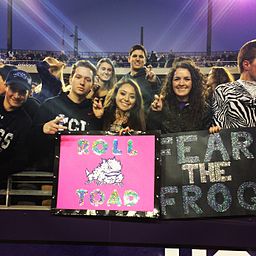Oct 20, 2016Ready for Some Football

After a long week spent in the athletic training room, in meetings, and on the practice fields, Saturday finally arrives — the day of the week everybody in the Texas Christian University football program looks forward to the most. It’s when all of the hard work and long hours finally pay off, and we get to see our work and passion take the field: game day.
For the athletic training staff, there are pros and cons to playing an early or late Saturday game. If we play early, (11 a.m. CST kickoff) we are done early, and I can maybe make dinner and a movie on Saturday night. But that means getting up early, too. Late games (6 or 7 p.m. CST kickoff) can be nice because I can take my time getting up and around in the morning and maybe run an errand or two I have been putting off for weeks — but that also means a late night. Mid-afternoon is really an ideal kickoff time, but we are generally at the mercy of the TV networks from week to week. The routine is generally the same, but for the sake of this piece, let’s walk through a typical late kickoff home game.
The football team stays at the team hotel the night before the game, which means the athletic training staff is there with them. We will usually meet the team for breakfast around 9 a.m., so we can make sure everyone is feeling good and no issues have come up overnight. Occasionally, we might stretch a few guys out or do a modality if indicated. After that, the athletic trainers are pretty much just on-call, so we’ll head back to our rooms to watch a little College GameDay on ESPN and catch the early games.
We typically like to arrive at the stadium about two hours before the team arrives, which is approximately four hours before the actual kickoff. I always enjoy the buzz around the stadium with all of the last-minute preparations and tailgaters kicking off their pregame parties.
Once we arrive and meet the athletic training students who will be assisting during the game, our first task is to get the field set up. This is normally done in conjunction with our equipment staff to make sure we all get our equipment staged in the proper positions. Sideline setup will take about 45 minutes to an hour and includes our hydration station, field trunk, treatment tables, bottle racks, bikes, oxygen, sideline tent, fans, and multiple coolers. Gatorade is our sponsor, so we always pay close attention to details to ensure we present a great sideline experience for the players and fans.
After setup is taken care of, we head back to the athletic training room and locker room to finalize any last-minute details. Most of the inside setup is completed on Friday afternoons, but everything is reviewed again on Saturday to ensure we have not missed anything. Then, honestly, it is our chance to relax and enjoy the calm before the storm. For the next 45 minutes to an hour, we have lunch, watch some college football, and mentally prepare for the rest of the day.
When the team arrives about two hours before the game, things get a little hectic. That’s when we start with treatments, taping, massage, stretching – and more taping. We try to make everything as smooth for the players as we can, so they can focus on what they need to do that day: play football.
Once all the players are prepped, my staff will get dressed in our game day attire and head out to the field to meet the visiting team’s athletic training staff. This is another one of my favorite parts of the day — getting to see friends I only see one or two times a year.
Coming out of the tunnel with the team, I feel like I am part of something big, something I would miss if I didn’t have it, something only a small number of people get to experience. It’s the payoff for the long offseason, the long days and weeks, and late nights. It’s all about the players, but inside, athletic trainers know we have contributed more than anyone will ever realize or appreciate.
Right before we head back inside with the team for some last-minute taping and hydration, we all have our little routines we have to follow. I always fist bump my strength coach and hug it out with my director of football operations. Superstition? Maybe.
About five minutes before kickoff, we head to the tunnel. Coming out of the tunnel with the team, I feel like I am part of something big, something I would miss if I didn’t have it, something only a small number of people get to experience. It’s the payoff for the long offseason, the long days and weeks, and late nights. It’s all about the players, but inside athletic trainers know we have contributed more than anyone will ever realize or appreciate. We do it for them, not for ourselves.
All athletic trainers hope for a quiet game, with no injuries for either team. Sometimes injuries are inevitable, but that’s what we are there for — calm the athletes’ fears, assure them we will make them better, and make them healthy again. After the game, it’s a quick postgame speech from the head coach, review the schedule for the upcoming week, treat the acute injuries, do a quick cleanup of the facility, and then breathe a sigh of relief.
And then we do it all over again 12 (and hopefully 14) times a year. It’s not for everyone. For those of us who are a part of it, I think we would all agree that there is nowhere else we would rather be on a Saturday in the fall.



